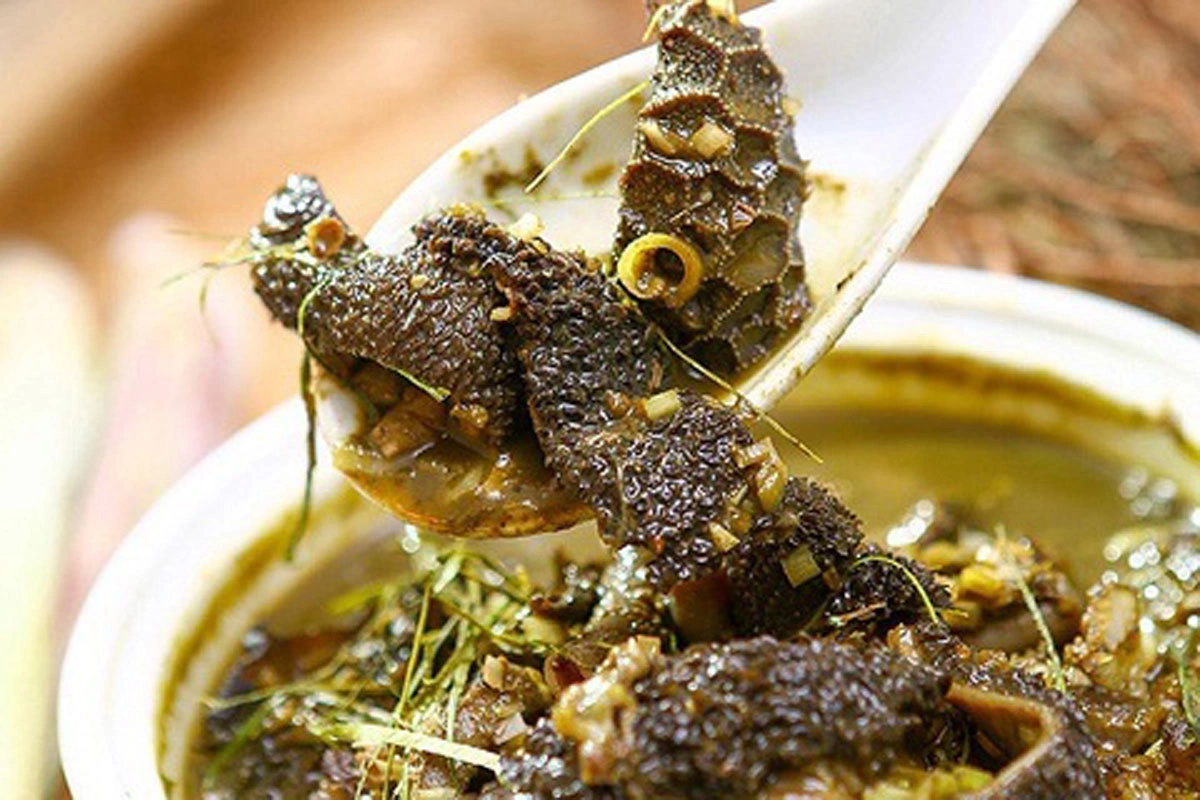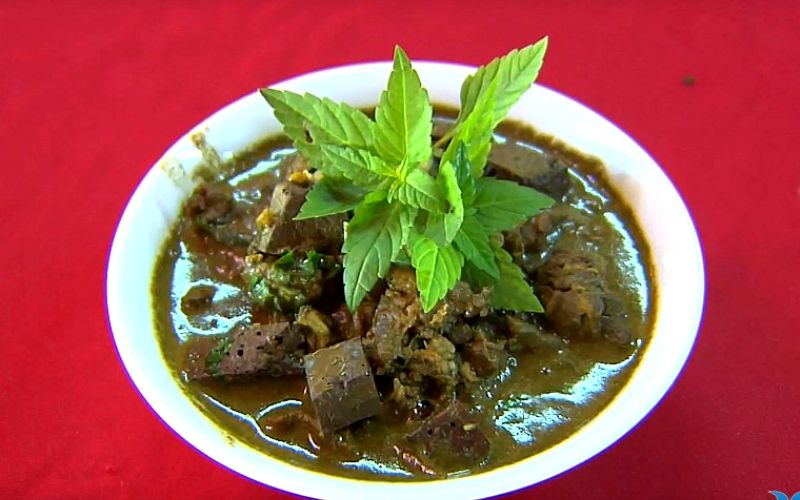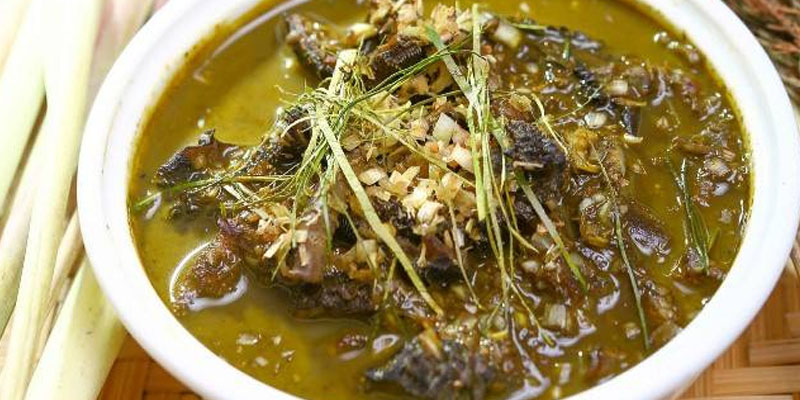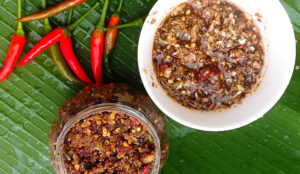Nam Pia: A Unique Specialty Of The Thai Ethnic People In The Northwest
Vietnamese cuisine is always known for its unique dishes that reflect the distinct flavors of different regions. Each dish not only carries its own characteristic taste but also reflects the culture and customs of its respective locality. One such dish is Nam Pia, a specialty of the Thai ethnic group in the Northwest region. Its unusual ingredients and distinct flavor have made Nam Pia an intriguing topic of discussion.

What is Nam Pia?
What is Nam Pia? Nam Pia is a traditional dish of the Thai ethnic group, often served during festivals, important events, or when hosting esteemed guests. The name “Nam Pia” originates from the Thai language, where “nam” means water or broth, and “pia” refers to a thick, sticky liquid extracted from the small intestine (caul) of animals such as cows, goats, etc.

It is precisely the unusual use of ingredients that makes Nam Pia both intriguing and challenging for many when it comes to tasting it.
Benefits of Eating Nam Pia
While Nam Pia may be difficult to stomach for those trying it for the first time, it offers many health benefits, such as:
Providing abundant energy: The ingredients in Nam Pia (including meat, cartilage, and internal organs) are rich in protein and fat. These components help replenish energy, making it particularly suitable for those doing heavy labor or recovering from illness.
Effective hangover remedy: Nam Pia is considered an effective “remedy” for alcohol, often enjoyed by people in the Northwest after a party.
Aids digestion: The components such as intestines, stomach, and small intestines in Nam Pia contain nutrients beneficial to the digestive system. Furthermore, this dish helps warm the stomach, aiding nutrient absorption and preventing intestinal issues.
Boosts immunity: With high levels of vitamins and minerals such as zinc, iron, and B vitamins, Nam Pia helps improve the body’s resistance to disease and maintain stable health.
Where is Nam Pia a Specialty?
Nam Pia is a unique and iconic dish of the Northwest region of Vietnam, especially popular in the provinces of Son La, Dien Bien, and Lai Chau. With its complex preparation and distinctive flavor, Nam Pia holds cultural value and reflects the creativity of the Thai people.
This dish often appears during festivals, weddings, or major events among the Thai people. For them, Nam Pia symbolizes hospitality and sincere affection, helping to strengthen community bonds through warm and festive gatherings.

For those who have visited the Northwest, tasting Nam Pia is an intriguing experience that allows them to discover the flavors of the highlands and gain a deeper understanding of the local culture.
Ingredients and Cooking Process of Nam Pia
The ingredients for Nam Pia include a variety of components such as frozen blood, tails, cartilage, meat, internal organs (stomach, intestines, liver), bamboo shoots, and small intestines. However, the most important ingredient is the thick liquid extracted from the small intestine of grass-eating animals like cows, goats, buffalo, or horses. This liquid, known as “pia,” is the defining element that gives Nam Pia its distinctive flavor.
The extraction of “pia” requires great care and attention to detail. The Thai people only select “pia” from grass-eating animals to ensure the quality and safety of the ingredient. Each step in extracting the “pia” is performed meticulously to preserve its quality and flavor, contributing to the uniqueness of this dish.
To successfully prepare Nam Pia, the first step is selecting a fresh, clean, and high-quality segment of small intestine, as this is the most important ingredient. The intestine is then tightly tied at both ends to separate it from the large intestine and stomach, ensuring that the emulsified liquid in the small intestine does not mix with impurities. The small intestine is then cut into short pieces and mixed with spices such as fragrant herbs, Mac Khen powder, cilantro, garlic, and finely chopped chili to enhance the flavor.
Preparing the ingredients is intricate, but the process of cooking Nam Pia is equally meticulous. The broth for this dish is made from bones and internal organs like intestines, liver, stomach, and other internal parts, all simmered for hours. This slow cooking process creates a sweet and rich broth. Once the broth reaches the right sweetness, the seasoned “pia” is added and boiled for about an hour until it thickens and becomes creamy.
Is Nam Pia Really “Difficult to Eat” as Rumored?
When learning about Nam Pia, you may encounter differing opinions about its flavor. With its unique taste and special preparation, Nam Pia might make many people hesitant to try it at first. After preparation, Nam Pia has a brown, sticky appearance, which might not be visually appealing. Additionally, its flavor is quite strange and may not be immediately enjoyable for first-time tasters.

However, if you can overcome the initial hesitation, Nam Pia can turn into an unforgettable culinary experience. The rich, fatty flavor of the “pia,” combined with the aromatic Mac Khen, garlic, and chili, will gradually melt away any apprehension and offer an incredibly unique taste that not many dishes can match. The perfect blend of fresh ingredients and special spices makes Nam Pia a must-try specialty when visiting the Northwest.



